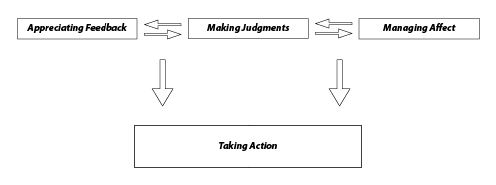Without understandings of how feedback operates, and its potential value it is difficult for students to appreciate and use feedback. Student feedback literacy denotes the understandings, capacities and dispositions needed to make sense of comments and use them for enhancement purposes (Carless & Boud, 2018). Four inter-related features represent the essence of students’ feedback literacy: appreciating feedback; making judgments; managing emotions; and taking action. These are presented in Figure 1 below.
Figure 1. Features of Student Feedback Literacy (Carless & Boud, 2018).

Students need to appreciate feedback processes and see their value. Students need sustained practice in making sound academic judgments about their own work and that of others. Students need to avoid defensive knee-jerk reactions to critical feedback and appreciate it as a tool for improvement. Most crucially, students need to take action to improve because unless comments are taken up, there is minimal value in feedback.
There are two key strategies to enable the development of student feedback literacy. Peer feedback facilitates student capacities in composing and receiving feedback. The analysis of exemplars supports students in seeing how quality is manifested.
The development of student feedback literacy is central to the enhancement of feedback processes and broader attempts to improve student learning outcomes. Through the development of feedback literacy, students are better positioned to use information to judge their own work. Feedback literacy is not just a tool for doing better in university studies but a core capability for the workplace and lifelong learning.
Key reading:
Carless, D. & Boud, D. (2018). The development of student feedback literacy: Enabling uptake of feedback. Assessment and Evaluation in Higher Education.